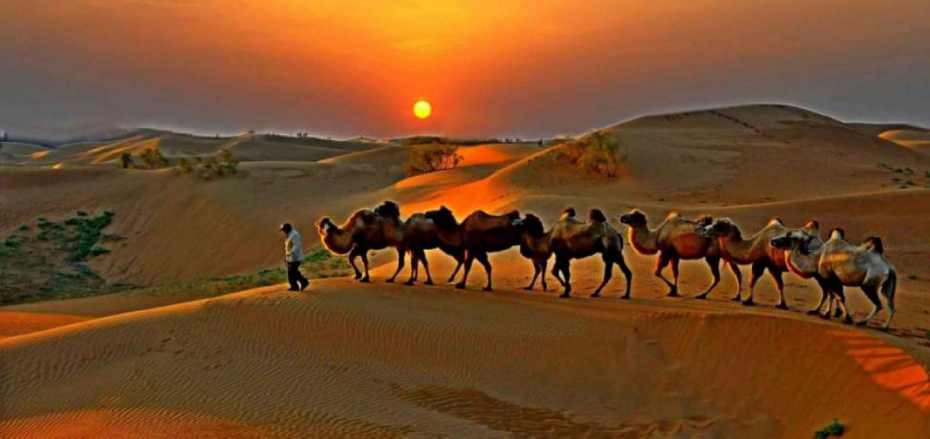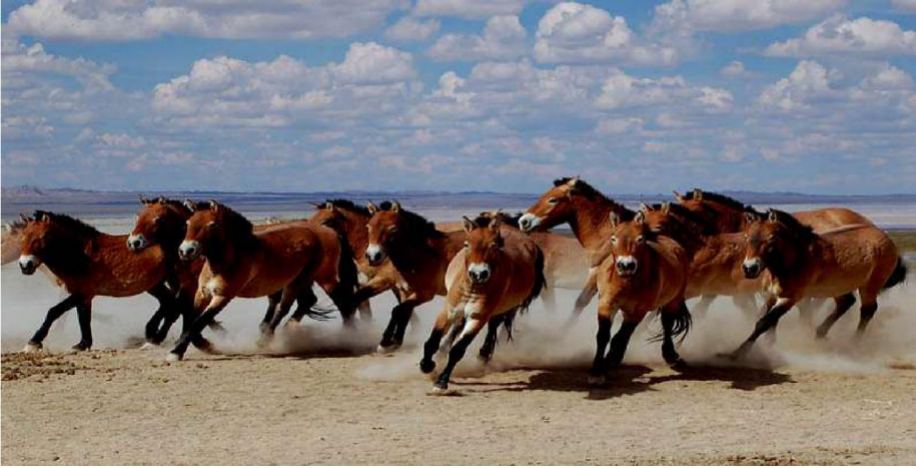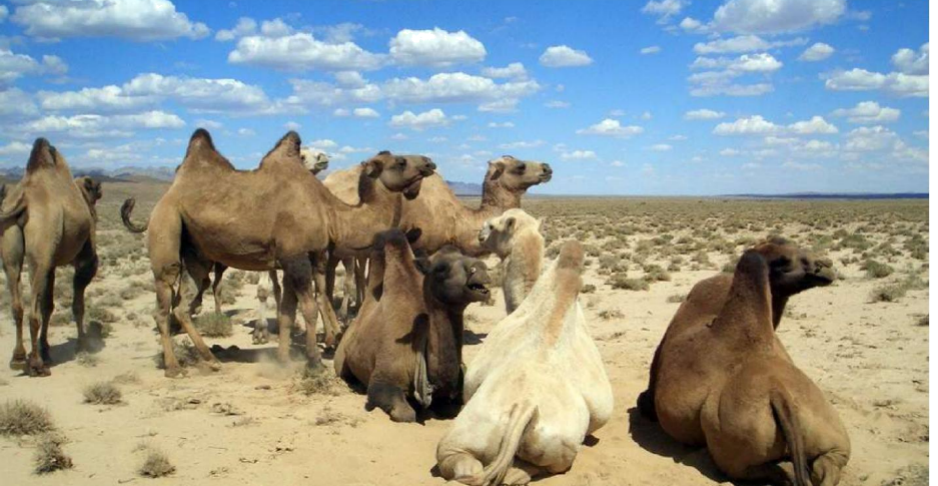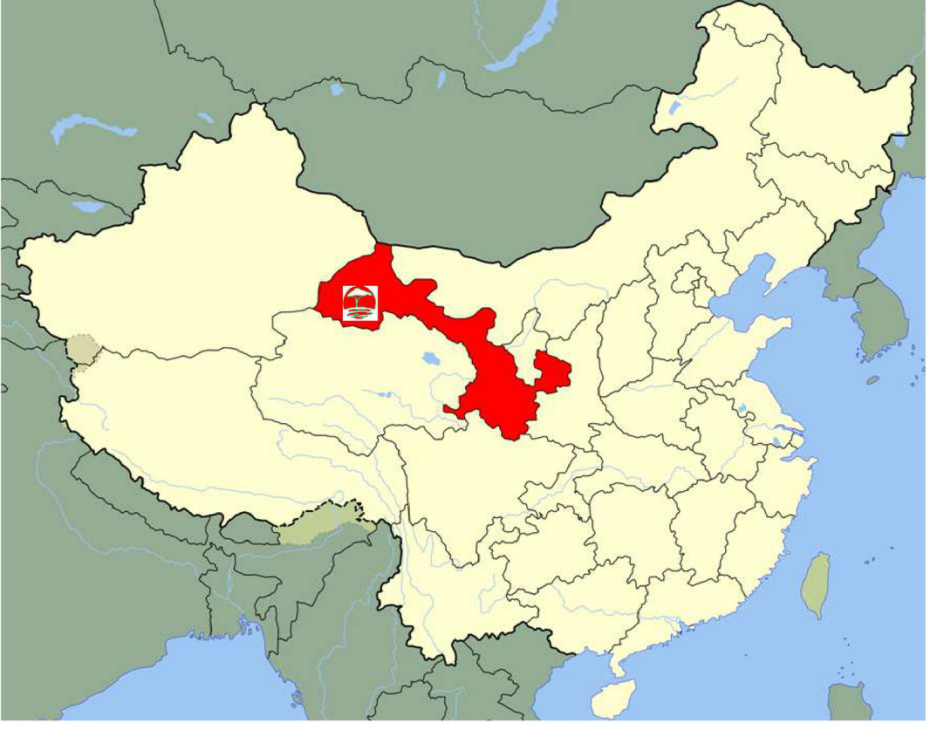Reintroduction of Przewalskii Horse and Double-hump Wild Camel Along the Silk Road

“There is a road, a road far enough to encourage you to conquer. It is so close to you cause your heart will get attached to it once you travelled through. This road, is well known as the Silk Road”.
For many centuries, the Silk Road was central to cultural interaction through regions of the Asian continent connecting the East and West from China to the Mediterranean Sea. Today, the Silk Road plays more important roles not only for the economic ties along the route, but also, plays a critical functions for the conservation of biodiversity and responsive plan to climate change, “the glory of the Silk Road is in history, the future of the Silk Road lies in ecosystem”, said by Leon Chen, the Operation Eartth Chief Science Officer.
Among many endangered species along the Silk Road, there is the only remaining truly wild horse in the world with the total population around 1500 individuals, the Przewalski's horse (Equus ferus przewalskii), is named after the Russian explorer Nikolai Przhevalsky. This subspecies of wild horse was presumed extinct in the wild between 1969 and 1992, while a small breeding population survived in zoos around the world. In 1992, it was reintroduced in the wild due to the conservation efforts of many conservation and reserves. Today, a small wild breeding poopulation exists in Northwest China and Mongolia.

The wild Bactrian camel (Camelus bactrianus) is a large, even-toed ungulate native to the Gobi desert of Northwest China and Mongolian Gobi. It has two humps on its back, in contrast to the single-humped dromedary camel. It is enlisted by as Annex 1 of SITES red-listed endangered species.
The population of wild Bactrian Camel is about 730 - 880 individuals in Northwest China, exact number of the population is still unknown.
Project Title | Reintroduction of Prewaskii Horse and Double-hump Camel Along the Silk Road |
Operation Earth Scientists | Prof. Sun Zhicheng, Director, Conservation and Research Dept., Dunhuang Xihu Wetland National Nature Reserve |
Research Site | Dunhuang Xihu Wetland National Nature Reservve, Gansu, China |
Rendezvous Point | Dunhuang Airport |
Expedition Length | 7 days (arrive at and leave at Dunhuang Airport) |
Scientific Research Fees | 17000 CNY |
Team Size Min./Max. | 8 – 14 volunteers |
Physical Demand | Medium |

Research Area:Biodiversity Conservation and Climate Change
Research Purposes: Provide long-term field monitoring data of desert wetland ecosystem along the silk-road of Northwest China for a better conservation plan of reintroduction of Prewaskii Horses and double hump camels of northwest China and their habitat as well as response plan of climate change in Xihu Wetland National Nature Reserve, Dunhuang, China.
The long-term aim of this project, led by Operation Earth scientist Mr. Sun Zhicheng, is to create healthy, self-sustaining population of both Przewalskii Horse and wild camel in their native habitat in the Xihu National Nature Reserve.
Field Research Activities:
You'll survey and monitor populations Przewalskii horse in the Xihu Reserve by undertake the following tasks, where you may also possibly spend a night camping.
1. Terrestrial Transect Survey of wildlife (active area of Prewaslkii horses and wild camel);
2. Identify the distribution area of wild camel;
3. Terrestrial Transect Survey of sand-tolerating plant species (Calligonum 沙拐枣, Haloxylon 梭梭) and Euphrates Poplar Forests 胡杨林), plant specimen collection an d production;
4. Survey of ecosystem and natural resources at the area of Shule River end (river channel)
5. Survey of cultural relics within the reserve (Han Dynasty Great Wall, beacon towers, ancient village remains, mining site, etc.). Within the field research site, it is also the World Cultural Heritage Site.
6. Collect field data to evaluate the impact of local communities to local ecosystem (Yangguan Township, Yangguan Historic and Scenic Area, Yangguan Forest Farm, Yadan Geopark, Duobagou Kazakh Ethnic Community) ;
7. Collect field data for the Environmental impact assessment (EIA) to the impact to local ecosystem by the local tourism development.
You'll also visit ethnic Kazakh ’s community in the Xihu Reserve, where you may also enjoying their indigenous song and dances with their courtesy.
Operation Earth Scientist: Mr. Sun Zhicheng, graduated from Gansu Agricultural University in 1980, has been worked for Dunhuang Municiple Forest Station, Urban Gardening Farm, Dunhuang Forest Administration, Dunhuang Wildlife Conservation Station, and since 2005, he is served as the Chief of Research Dept. of Dunhuang Xihu Wetland National Nature Reserve, responsible for the promotion of forest science popularization, survey and plan of natural resources of the Reserve, monitoring and conservation of ecological and wildlife of the Reserve.
About the Research
I. Research Site
Dunhuang Xihu Wetland National Nature Reserve with the total area of 6,600 km2(about 2.3 times larger than that of Yosemite National Park), located at 80 km of southwest of Dunhuang City, east to Kumtagh Desert, north to Xinjiang Uygur Autonomous Region. The geographic coordinates o the Reserve is: 92°45′ - 93°50′E, 39°45′-40°36′N.
This nature reserve is a typical type of inland wetland, desert ecosystem and wild animal and sand-enduring plant. The region has a large area of indigenous natural vegetation, rare wildlife and natural wetlands, it has very important strategic position in the conservation of ecological environment in Western China it is critically related with the ecological security of Dunhuang Civilization which dates back to more than 3000 years.
Due to global climate change and the desertification aggravated by increasing human activities threatens the ecosystem, Lop Nor Lake has been dry up since 1950s and becomes a desert area, two larger deserts of Kumtagh and Taklimakan Deserts might be connected if no proper and urgent measures are taken, this Reserve is the critical eco-barrier to prevent two great deserts to meet and the last ecological defense line to protect Hexi Corridor of Gansu Province from invasion by Taklimakan Desert.
Thus, the Reserve is critically important to the protection of ecosystem of Northwest China, improving the regional climate, ensure sustainable agricultural production and tourism industry, especially the protection of the world cultural heritage site of Mogao Grottoe.
The Przewalski's horse (Equus ferus przewalskii), is named after the Russian explorer Nikolai Przhevalsky. This subspecies of wild horse was presumed extinct in the wild between 1969 and 1992, while a small breeding population survived in zoos around the world In 1992, it was reintroduced in the wild due to the conservation efforts of many conservation and reserves. Today, a small wild breeding population exists in Northwest China and Mongolia.
The total population of Przewalskii horse in the wild is around 1500 individuals. In order to increase the population of Przewalskii H orse, improve their wildness, Gansu Research Center for Endangered Species released 7 Przewalskii horse at Xihu National Nature Reserve on Sept. 25, 2010, and carried out closed monitoring of their behavior (active area, feeding, water pond, physical health condition, body color, and metabolize, etc.), repeated mating have been witnessed and several ponies have been reproduced and survived. It shows that the released Przewalskii horse already adapted local conditions of the Reserve, and the Reserve has the favorable conditions for the reintroduction of Przewalskii horse.
This field research volunteer expedition is mainly works at Conservation Stations of Yumen Guan Pass and Lucaojing (Reed Well in Chinese).
The test of the reintroduction of Przewalskii horse in Dunhuang has made some achievements, the first 7 Przewalskii horses in two years not only adapted to local conditions and habitat of the Reserve, but also have successful bred several generations of health ponies. However, the research work of reintroduction of Przewalskii horse is a long-term and arduous task. For the final success of reintroduction of Przewalski's horse, continued monitoring and research will be carried out for next stage. At present, the Dunhuang West Lake national protected area of Przewalski's horse has reached 34 horses.
The wild bactrian camel (Camelus bactrianus) is a large, even-toed ungulate native to the Gobi desert of Northwest China and Mongolian Gobi. It has two humps on its back, in contrast to the single-humped dromedary camel. It is enlisted by as Annex 1 of SITES red-listed endangered species. It is one of most important endangered species within Xihu National Nature Reserve. The population of wild Bactrian Camel is about 730 - 880 individuals in Northwest China, exact number of the population is still unknown.
Can this typical species of steppe ecosystem, both the Przewalskii horse and wild camel, be survive in the future at the Gobi desert area of Dunhuang Xihu National Nature Reserve, is still need long-term and continuous monitoring.
II. Purposes and Objective of the Research
2.1 Purposes
- Provide scientific data for better conservation plan and practice for Dunhuang Xihu National Nature Reserve whom plays critical and strategic role for the ecological conservation and rehabilitation in Northwest China.
2.2 Objective:
- Monitoring dynamic status off population structure and their behaviors of Przewalskii Horse, wild camels and water birds;
- Monitoring dynamic status of habitat for the key and indicative species of dry-enduring plans and vegetations and their community, such as Calligonum 沙拐枣, Haloxylon 梭梭, Euphrates Poplar
Forests 胡杨林, etc.
- Inform and educate local co munities and villagers not to hunting and cutting;
- Collect field data to evaluate the impact of local communities/ecosystem (Yangguan Historic & Scenic Area, Yangguan Forest Farm, Yadan Geopark, Duobagou Ethnic Kazakh Community for the Environmental impact assessment (EIA) to the impact to local ecosystem by tourism development.
III. Field Research Method
On the first day of field work, w e will conduct a short training session, present knowledge of identification and monitoring methods of Przewalskii Horse and wild camel, water birds, and habitat evaluation, etc. During entire fielding period, our team will be divided into several groups to undertaken different field works and every group will shift to undertake all different tasks.
We will also exchange with local communities, especially the ethnic Kazakh community, for their roles and livelihood as well as their suggestions and participatory plan for the conservation of ecosystem, as their participation is critical for the success of the conservation.
IV. Itinerary of the field reseaarch volunteer expedition
Field Work Plan | ||
Day 1 | 13:00 Rendezvous at Dunhuang Airport 15:00 Drive to the conservation Stations of Yumen Guan Pass or Lucaojing (welcome session ) 18:30 Dinner 19:30 Field research expedition brief, work arrangement, safety brief, etc. | |
Day 2 | 08:00-09:00 Breakfast 09:00-11:30 Familiarize with local topography, actual site, habitat of Przewalskii horses and wild camel, behavior, population structure. Research methods and tasks, safety issues, 11:30-13:00 Lunch 14:00-17:00 Field research activities: Group 1: Terrestrial transect survey of wildlife (active area of Prewaslkii horses & wild camel) Group 2: Identify the distribution area of wild camel Group 3: Terrestrial Transect Survey of sand-tolerating plant species (Calligonum 沙拐枣,Haloxylon 梭梭 and Euphrates Poplar Forests 胡杨林), plant specimen collection and production; 18:30 Dinner 19:30-21:00 Evening Session (data collection brief and input into computer) | |
Day 3 | 08:00-09:00 Breakfast 09:00-18:00 Field research activities: Group 1: Terrestrial Transect Survey of wildlife (active area of Prewaslkii horses & wild camel) Group 2: Identify the distribution area of wild camel Group 3: Terrestrial transect survey of sand-tolerating plant (Calligonum 沙拐枣, Haloxylon 梭梭, Euphrates Poplar Forest 胡杨林), plant specimen collection and production; 18:30 Dinner 19:30-21:00 Evening Session (data collection brief and input into computer) | |
Day 4 | 08:00-09:00 Breakfast 09:00-18:00 Field researcch activities: Group 1: Terrestrial Transect Survey of wildlife (active area of Prewaslkii horses & wild camel) Group 2: Identify the distribution area of wild camel Group 3: Terrestrial transect survey of sand-tolerating plant (Calligonum 沙拐枣, Haloxylon 梭梭, Euphrates Poplar Forest 胡杨林), plant specimen collection and production; 18:30 Dinner 19:30-21:00 Evening Session (data collection brief and input into computer) | |
Day 5 | 08:00-09:00 Breakfast 09:00-16:30 Field researcch activities: Group 1: Survey of ecosystem and natural resources at Shule River end (river channel) Group 2: Survey of cultural relics within the reserve (Han Dynasty Great Wall, beacon towers,ancient village remains, mining site, etc.). Within the field research site, it is also the World Cultural Heritage Site. Whole team: Collect field data to evaluate the impact of local communities/ecosystem (Yangguan Historic & Scenic Area, Yangguan Forest Farm, Yadan Geopark, Duobagou Ethnic Kazakh Community for the Environmental impact assessment (EIA) to the impact to local ecosystem by tourism development 17:00-18:30 Back to downtown of Dunhuang City from the field 19:00-20:00 Dinner | |
Day 6 | 08:00-09:00 Breakfast 09:00-11:30 Visit World Cultural Heritage Site – Mogao Caves 12:00-13:30 Lunch 14:00-15:00 Wrap up meeting 15:30 -19:00 Visit Echoing-sand Mountain and Crescent Lake 19:30-21:00 Dinner | |
Day 7 | 07:30 - 08:00 Breakfast 09:00 - 11:30 Dunhuang City Tour 11:30-12:30 Lunch 13:30 Leave for Dunhuang Airport, complete this exciting expedition | |
![]()
![]()
![]()
![]()
![]()
![]()
![]()
Tips: Dunhuang is the top tourist city in China. Its incredible beauty is difficult to be described in words. Its key points of interest and natural sights are shockingly beautiful and capable of tugging at one's heart. The Pearl of thee Silk Road, Dunhuang, opens her arms to welcome visitors from all over the world.
Historically, Dunhuang was one of the four frontier garrison towns (along with Jiuquan, Zhangye and Wuwei) established by the Emperor Wu after the defeat of Xiongnu, and the Chinese built fortifications at Dunhuang and sent settlers there. The name Dunhuang, meaning "Blazing Beacon", refers to the beacons lit to warn of attacks by marauding
nomadic tribes. Dunhuang Commandery was probably established shortly after 104 BC. Located in the western end of the Hexi Corridor near the historic junction of the Northern and Southern Silk Roads, Dunhuang was a town of military importance
Mogao Caves: Located 25 km southeast of Dunhuang, Mogao Caves is regarded as the premier Buddhist spot in China, perhaps in whole
world. It is listed as the World Cultural Heritage Site in 1987. The artistic features of the treasured
Buddhist murals represent perfectly the artistic style of the Northern Wei (386-543), Sui (581-618) and Tang (618-907) dynasties through the combination of the architecture, statues and murals in the caves.
Presently, there are about ten caves and two exhibition centers open to the public, occasionally more during public holidays.
Echoing-Sand Mountain: Five kilometers south of the city, Echoing-Sand Mountain is the accumulation of years of sand in the size of rice. Each time the wind blows,, there is a sound from the mountain and when there is a breeze, the sound is like musical instruments, hence the name. The most marvelous experience is when after climbing to the top, although quite strenuous, one can slide down to the foot of the mountain, a wonderfully amusing experience!
Crescent Lake: 5 km southwest of the city, the Crescent Lake lies in the arms of Echoing-Sand Mountain, appearing clear and beautiful. The lake is crescent-shaped, hence the name. It's surrounded by quicksand. Although it's quite windy sometimes, the lake has never been covered by the sand. It's really a marvelous spectacle in the desert.
Yumen Guan Pass, Situated 90 km (56 miles) northwest of the city, the Yumen Pass was an important gateway to the western region in ancient times. Yumen Pass, Hecang Town and Han Great Wall (Han Dynasty), are the major sights in this area. Since the Yangguan Pass and the Yumen Pass are a distance from Dunhuang, one can have a feel for the desolation of western China. Tang Dynasty (618 – 917 AD) frontier poet Wang Zhihuan's "Why Qiang (ethnic group) flute blame willows sadly, cause spring never breeze over Yumen Pass” has win universal praise in China since 7th century.
Yangguan Pass (Sun Pass), was built in 111 BC during the Han Dynasty (202BC – 220AD), located 70 km (44 mile) southwest of the city, is the gateway to the south western region along the Silk Road. The beacon tower is all that remains of the Pass. Tang Dynasty (618 – 917 AD) poet (Wang Wei) "Persuade you to drink one more cup (of wine), as there will be no old friends after you go west of Yangguan Pass” has made Yangguan Pass very famous in the history of China.
Dunhuang people are enthusiastic and friendly, with a simple smile to greet the arrival of the field research volunteers expedition team of Operation Earth. Let us work hard to monitoring and conserve the precious and fragile ecosystem of the world cultural heritage of Dunhuang, and never allow this Dunhuang becomes the second Kroraina!
